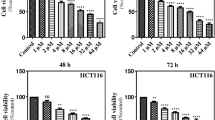Abstract
S-adenosylhomocysteine hydrolase (SAHH) is the sole enzyme that catalyses the hydrolysis of S-adenosylhomocysteine (SAH) in methylation reaction. Previous studies have shown that its inhibition or deficiency leads to several human disorders such as severe coagulopathy, hepatopathy and myopathy. However, the effects of SAHH on esophageal squamous cell carcinoma (ESCC) cells have not been explored so far. To determine whether SAHH is involved in carcinogenesis of the esophagus, we investigated the expression of SAHH in ESCC and normal esophageal epithelial cells and found that SAHH was downregulated in ESCC cells compared with normal esophageal epithelial cells (P < 0.05). The overexpressed SAHH in ESCC cells promoted cell apoptosis, inhibited cell migration and adhesion, but did not affect the cell proliferation and cell cycle. Furthermore, an interaction of SAHH with receptor of activated C kinase 1 (RACK1) protein was detected by coimmunoprecipitation and an increased RACK1, which is caused by overexpression of SAHH, was verified by Western blotting. The findings mentioned above demonstrate that SAHH can promote apoptosis, inhibit migration and adhesion of ESCC cells suggesting that it may be involved in carcinogenesis of the esophagus.






Similar content being viewed by others
References
Hou GQ, Zhang Q, Wang LL, Liu MY, Wang JR, Xue LX (2010) mTOR inhibitor rapamycin alone or combined with cisplatin inhibits growth of esophageal squamous cell carcinoma in nude mice. Cancer Lett 290:248–254
Nakanishi M (2007) S-adenosyl-l-homocysteine hydrolase as an attractive target for antimicrobial drugs. J Pharm Soc Jpn 127:977–982
Tanaka N, Nakanishi M, Kusakabe Y, Shiraiwa K, Yabe S, Ito Y, Kitade Y, Nakamura KT (2004) Crystal structure of S-adenosyl-l-homocysteine hydrolase from the human malaria parasite Plasmodium falciparum. J Mol Biol 343:1007–1017
Zaina S, Lindholm MW, Lund G (2005) Nutrition and aberrant DNA methylation patterns in atherosclerosis: more than just hyperhomocysteinemia? J Nutr 135:5–8
Honzík T, Magner M, Krijt J, Sokolová J, Vugrek O, Belužić R, Barić I, Hansíkova H, Elledera M, Veselá K, Bauerová L, Ondrušková N, Ješina P, Zeman J, Kožich V (2012) Clinical picture of S-adenosylhomocysteine hydrolase deficiency resembles phosphomannomutase 2 deficiency. Mol Genet Metab 107:611–613
Leal JF, Ferrer I, Blanco-Aparicio C, Hernández-Losa J, Ramóny Cajal S, Carnero A, LLeonart ME (2008) S-adenosylhomocysteine hydrolase downregulation contributes to tumorigenesis. Carcinogenesis 29:2089–2095
Hermes M, Osswald H, Riehle R, Piesch C, Kloor D (2008) S-adenosylhomocysteine hydrolase overexpression in HEK-293 cells: effect on intracellular adenosine levels, cell viability, and DNA methylation. Cell Physiol Biochem 22:223–236
Sedding DG, Trőbs M, Reich F, Walke G, Fink L, Haberbosch W, Rau W, Tillmanns H, Preissner KT, Bohle RM, Langheinrich AC (2009) 3-Deazaadenosine prevents smooth muscle cell proliferation and neointimaformation by interfering with Ras signaling. Circ Res 104:1192–1200
Hayden A, Johnson PW, Packham G, Crabb SJ (2011) S-adenosylhomocysteine hydrolase inhibition by 3-deazaneplanocin A analogues induces anti-cancer effects in breast cancer cell lines and synergy with both histonedeacetylase and HER2 inhibition. Breast Cancer Res Treat 127:109–119
Wang LL, Hou GQ, Xue LX, Li J, Wei P, Xu P (2010) Autocrine motility factor receptor signaling pathway promotes cell invasion via activation of ROCK-2 in esophageal squamous cell cancer cells. Cancer Invest 28:993–1003
Li QH, Zhu LQ, Yan YM, Chai DD, Li J, Xue LX (2013) S-Adenosyl homocysteine hydrolase (SAHH) accelerates flagellar regeneration in Dunaliella salina. Curr Microbiol 164:1028–1034
Palmer JL, Abeles RH (1979) The mechanism of action of S-adenosylhomocysteinase. J Biol Chem 254:1217–1226
LLeonart ME, Vidal F, Gallardo D, Diaz-Fuertes M, Rojo F, Cuatrecasas M, López-Vicente L, Kondoh H, Blanco C, Carnero A, RamónyCajal S (2006) New p53 related genes in human tumors: significant down regulation in colon and lung carcinomas. Oncol Rep 16:603–608
Harrington EO, Smeglin A, Parks N, Newton J, Rounds S (2000) Adenosine induces endothelial apoptosis by activating protein tyrosine phosphatase: a possible role of p38 alpha. Am J Physiol 279:733–742
Barry CP, Lind SE (2000) Adenosine-mediated killing of cultured epithelial cancer cells. Cancer Res 60:1887–1894
Hermes M, Osswald H, Kloor D (2007) Role of S-adenosylhomocysteine hydrolase in adenosine-induced apoptosis in HepG2 cells. Exp Cell Res 313:264–283
Borley AC, Hiscox S, Gee J, Smith C, Shaw V, Lee B, Nicholson P (2008) Anti-oestrogens RI. But not oestrogen deprivation promote cellular invasion in intracellular adhesion-deficient breast cancer cells. Breast Cancer Res 10:R103
Coskun U, Sancak B, Sen I, Bukan N, Tufan MA, Gülbahar O, Sozen S (2006) Serum P-selectin, soluble vascular cell adhesion molecule-I (s-VCAM-I) and soluble intracellular adhesion molecule-I (s-ICAM-I) levels in bladder carcinoma patients with different stages. Int Immunopharmacol 6:672–677
Shi S, Deng YZ, Zhao JS, Ji XD, Shi J, Feng YX, Li G, Li JJ, Zhu D, Koeffler HP, Zhao Y, Xie D (2011) RACK1 promotes non-small-cell lung cancer tumorigenicity through activating sonic hedgehog signaling pathway. J Biochem 287:7845–7858
Wang F, Osawa T, Tsuchida R, Yuasa Y, Shibuya M (2011) Downregulation of receptor for activated C-kinase 1 (RACK1) suppresses tumor growth by inhibiting tumor cell proliferation and tumor-associated angiogenesis. Cancer Sci 102:2007–2013
Deng YZ, Yao F, Li JJ, Mao ZF, Hu PT, Long LY, Li G, Ji XD, Shi S, Guan DX, Feng YY, Cui L, Li DS, Liu Y, Du X, Guo MZ, Xu LY, Li EM, Wang HY, Xie D (2011) RACK1 suppresses gastric tumorigenesis by stabilizing the β-catenin destruction complex. Gastroenterology 142:812–823
Wang ZY, Chen ZL, Feng M, Shi SS, He J, Dai GH (2011) The relationship between RACK1 expression and clinicopathologic information of esophageal squamous cell carcinoma. J Chin Med 91:1397–1400
Acknowledgments
This study was supported by the grants from International Science and Technology Cooperation Program of the Ministry of Science and Technology of P.R. China (No. 2007DFA01240), and the National Natural Science Foundation of China (No. 30700014)
Conflict of interest
There are not any conflicts of interest regarding this paper.
Author information
Authors and Affiliations
Corresponding author
Rights and permissions
About this article
Cite this article
Li, Q., Mao, L., Wang, R. et al. Overexpression of S-adenosylhomocysteine hydrolase (SAHH) in esophageal squamous cell carcinoma (ESCC) cell lines: effects on apoptosis, migration and adhesion of cells. Mol Biol Rep 41, 2409–2417 (2014). https://doi.org/10.1007/s11033-014-3095-8
Received:
Accepted:
Published:
Issue Date:
DOI: https://doi.org/10.1007/s11033-014-3095-8




